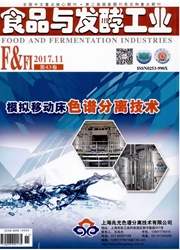

 中文摘要:
中文摘要:
采用无机盐培养基毕赤酵母发酵生产重组人溶菌酶,以人工配置的标准溶液作为建模集,利用ATR—FTIR结合PLS建立甘油和甲醇的预测模型,模型具有良好的稳定性和预测性,甘油预测模型的SEC和SEV分别为0.171和0.532g/L,甲醇预测模型的SEC和SEV分别为0.129和0.248g/L。在5L发酵罐中运用建立的模型预测发酵液中甘油和甲醇的浓度,预测标准误差(SEP)分别为1.09和0.86g/L,表明模型稳定,能有效指导实际生产。比较5L发酵罐中分别采用FTIR调控和溶氧(DO-stat)调控甲醇浓度下的比生长速率(p)和比生产速率(Qp),结果表明,FTIR调控下比生长速率和比生产速率均高于溶氧(DO-stat)调控。
 英文摘要:
英文摘要:
Mid-infrared FTIR spectroscopy is an efficient tool for the monitoring of bioprocesses. The use of Fourier transform mid-infrared spectroscopy (FTIR) combined with PLS to predict the concentrations of glycerol and methanol in fed-batch cultivations of Pichia pastoris in a chemical medium was investigated by using the synthetic solutions as calibration set. Generally, all models were robust and performed well, the calibration model allowed stand-rd errors of calibration (SEC) and standard errors of validation (SEV) for glycerol and methanol concentrations of 0. 171, 0. 532, 0. 129 and 0. 248 g/L, respectively. The results from 5 L Fed-batch experiments showed that FTIR data had a good agreement with control data, with standard error of prediction (SEP) of 1.09 and O. 86 g/L, respectively. Specific growth rate and specific production rate were compared between FTIR and DO-star to control methanol concentration. Results showed that FTIR could limit the methanol concentration under 2% , which could maintain a higher specific growth rate and specific production rate that was effective to enhance the production.
 同期刊论文项目
同期刊论文项目
 同项目期刊论文
同项目期刊论文
 期刊信息
期刊信息
